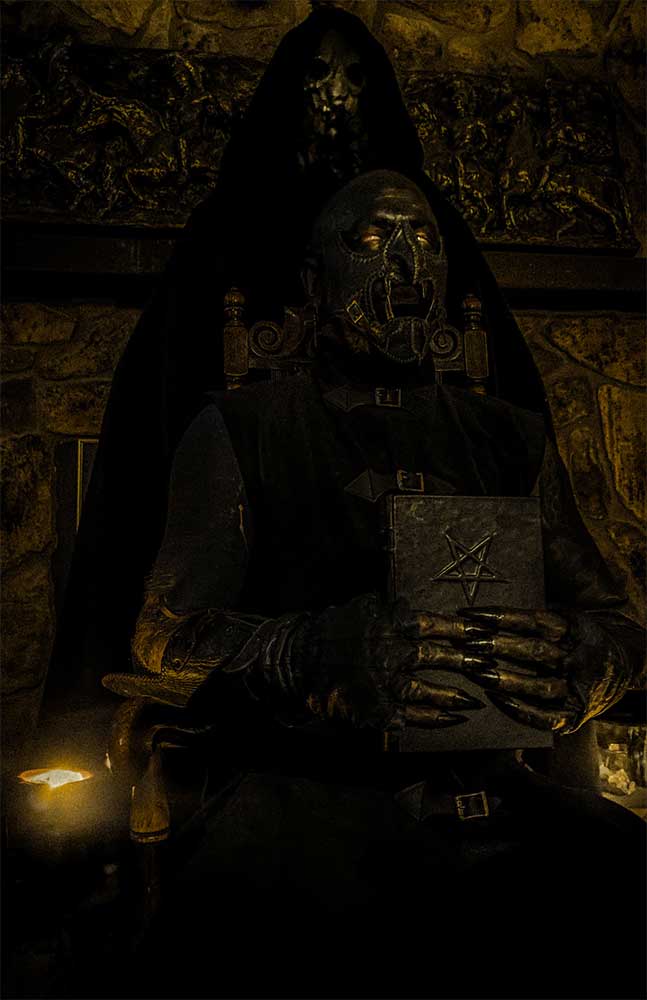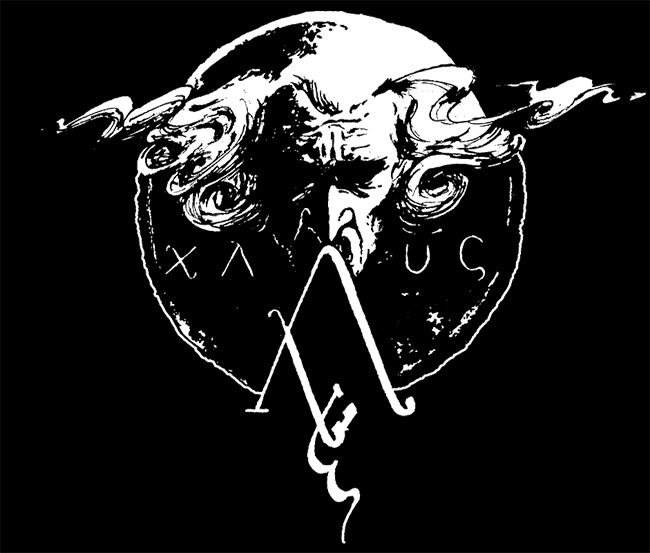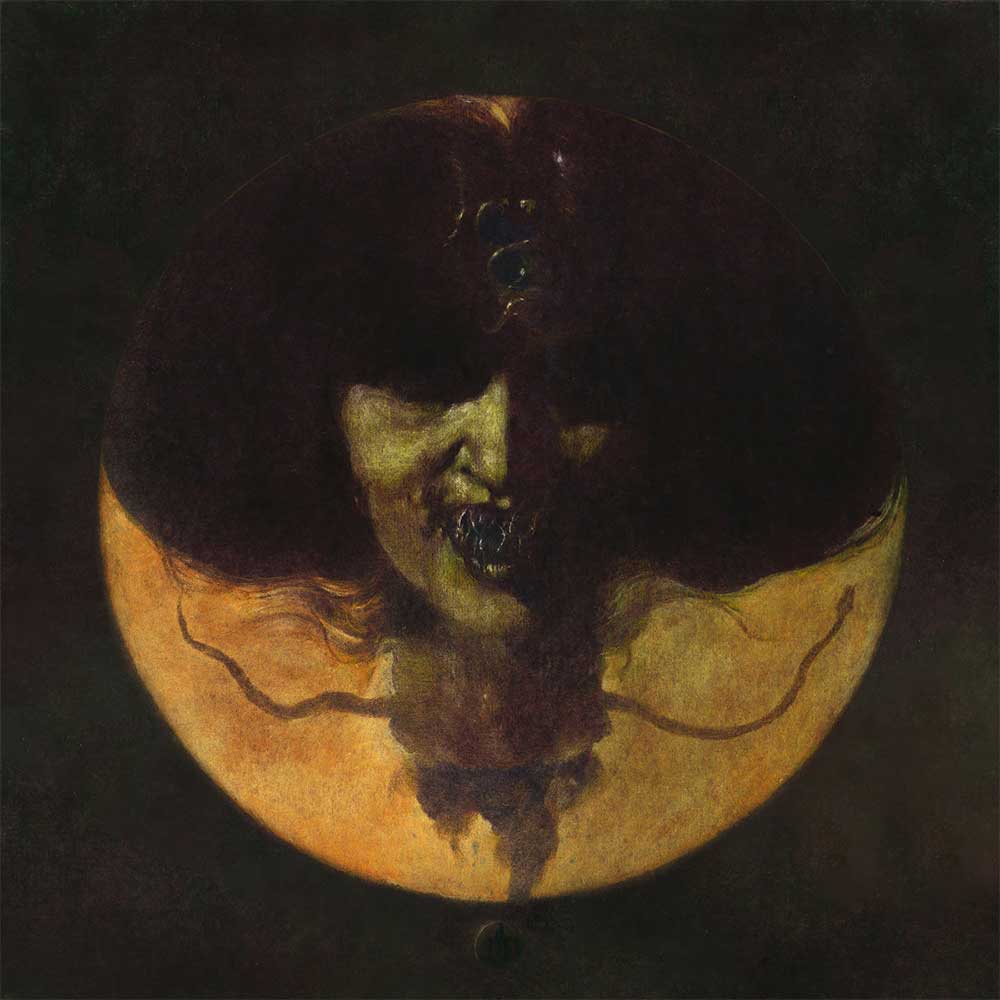Akhlys
2020-10-14
by Niklas Göransson
Dream of the darkness: Colorado-based black metal band Akhlys is a musical vessel for nocturnal exploration, courtesy of founder and frontman Naas Alcameth.
– I wanted to create an outlet for the many strange occurrences I’ve been through either whilst dreaming, falling asleep, or waking up. Direct and personal experiences, as opposed to speculation or second-hand philosophising on purported mystical or occult circumstances; consequently, these are the ones I hold most sacred. They’re also largely responsible for my esoteric interests, as I’ve been undergoing seemingly inexplicable phenomena around sleeping and dreaming for as long as I can recall. Whatever all this actually is, it’s been highly formative. Events such as these have a highly particular ‘feeling’, like a hallmark which identifies and unifies them. Those who have experienced something like this before immediately realise what’s going on, even without being able to sufficiently articulate it. This ‘feeling’, ‘spirit’, ‘essence’, or whatever one wishes to call it – this ‘thing’ that is equal parts dread and fascination, just as much ‘inside’ as it is ‘outside’ of us – is exactly what I wanted to embody with AKHLYS, because it is sacred to me.
“Melinoë”, the third album of AKHLYS, is set for release by Debemur Morti in December 2020. As he did with both NIGHTBRINGER and AORATOS, Naas Alcameth recorded it in Promethean Forge Studios and then worked with Dave Otero of Flatline Audio on mixing and mastering.
– Promethean Forge is what I call my own humble home studio. I do all the guitar, bass, keyboard, ambient, and vocal tracking on my own. This allows me to work as I please, on my own, whenever inspiration strikes – which has many benefits. Afterwards, we do the drums, mixing, and mastering with Dave at Flatline Audio. As far as the production goes, this usually comes about through a lot of back and forth conversation with Dave. We’ve been working together so long now that he understands the sound I’m chasing just as well as I do. It’s less a matter of differentiating productions between albums as it is about the overall sound we’re forever pursuing. We have this vision of what it should sound like, or what atmosphere should be relayed, and we chase it. It’s an ideal more so than something that can actually be realised; the point is to get as close to the mark as possible.

Another common ground with AORATOS is the use of a very distinct type of mask. A while back, Naas came across James Hodgson of Empirics Emporium – a mask-maker from the UK who only uses natural materials as well as old techniques and antique tools.
– I’ve been communicating with James over the last year, and he’s created several ritual masks based on my designs. The result have been superb, both aesthetically and on a deeper and more personal level. He also has a background in certain occult schools, so it was a perfect match really; he’s very enthusiastic about the ideas behind it all and adds lots of valuable input. The masks are symbolic of ‘other becoming’, as well as the sacred blackening fire, the radiant black flame, the Devil, and the powers of Death. Here we are becoming as the ‘Black Man of the Sabbath’ or the ‘Coal Black Smith’ who is – as the Veil and Masks chapter of Martin Duffy’s The Devil’s Raiment states – ‘evocative of both the divine blacksmith and the Horned God of the Opposer… the black-faced devil who dances within the hellish flames of the forge’.
While rarely as elaborate as these are, masks have seen a fair bit of inflation in the scene over the past few years.
– Of course, the use of masks is nothing new and even a bit tiresome at this point. However, whenever I see any of these things turn into a trend, I remind myself not to look at what’s going on outside – what others are or aren’t doing – and remain obsessed with my personal vision without considerations for the world at large. This self-obsession helps keep the artistic intent pure. The issue is when you step outside of this vision, looking for checks and balances to validate your uniqueness. Originality holds no value in and of itself and is not always an indication of legitimacy. At any rate, these things need to be approached with sincerity and integrity. As such, I put a lot of thought into the symbolism of it all, what it represents, how it should look and be constructed, and so on. Masks can be an immensely powerful way of concealment whilst simultaneously, in a fethishistic manner, outwardly embodying the darker aspects of one’s inner self.

After the AORATOS interview last year, Naas and I discussed in private various herbal dream catalysts such as black henbane, bobinsana, and Calea zacatechichi – also known as Mexican dream herb. I believe he’s tried them out by now, so I’m keen to hear his assessment.
– I’ve used henbane in miniscule dosages applied topically via a ‘flying ointment’, but without dramatic results. Both bobinsana and Mexican dream herb had more notable effects, but neither resulted in any sort of visitation event. Rather, I felt as if I had literally dreamed all night long, falling in and out of lucidity, which leaves you feeling as if you haven’t rested at all. It’s something I plan to experiment with further. I must say though, I wouldn’t advise anyone to take Calea zacatechichi as a tea infusion – it did not prove remarkably effective and is barely palatable.
That is Naas’ polite way of saying that it tastes like fucking death. Sort of like wormwood, but with an ashtray emptied in it. The best way is to vaporise it before bed. If smoked through a pipe, the dream effects come immediately, before one falls asleep – however, the smoke is so unbelievably nasty that it’s near-impossible to consume the required amount. Vapour is the way to go. The sort of dream visitation Naas is referring to is what’s known as sleep paralysis: often described as the worst imaginable nightmare played out in a waking state, during which one is incapable of moving anything but the eyes. Up to fifty percent of all people experience this at some point in their lives, often during childhood, and about five percent undergo it regularly. A central feature is often being forcefully pinned down by what’s perceived as a hostile presence, an ordeal which by all accounts is absolutely terrifying. Before it became a medical term, folklore identified the phenomenon as various kinds of demonic attacks.
– During the beginning of the writing process, I had this window of time where I was suffering nightmares and, subsequently, sleep paralysis quite consistently for just over a week. The older I get, the more infrequent these things have become. I’d say that the timing was quite uncanny, except that it coincided with the tail-end of some legal troubles and the beginning of all this COVID strangeness. Given how stress and anxiety are often catalysts for such events, it wasn’t really shocking. Anyhow, I started using the voice memo app on my phone to record myself whilst sleeping. It was during the second or maybe third night that I had a very pronounced sleep paralysis episode complete with the ‘visitation’, or whatever one wants to call it. What I captured on audio was sleep-talking from this instance. It’s very ‘strangled’ sounding and between laboured breaths, which is due to the oppressive nature of these encounters – one feels physically weighed down and breathing is restricted.
Naas told me this recording can be heard in the third track, “Succubare”. Listening to the song in question, my initial assumption was that it had been used in the intro – which contains a harrowing cacophony of noise that feels like insects crawling all over – but this turns out not to be the case.
– One of the keyboard layers in the very beginning is comprised of dissonant violins, then, right at the second bell toll, another voice comes in. That’s actually combined samples of shrieking baboons and swarming flies, so I’m guessing the latter is what you’re hearing. The flies sound as if they’re hitting wet flesh, which has this really disturbing and unpleasant quality to it. Mind you, I didn’t create these voices myself; they’re all native within a synth program called Omnisphere. I manipulated the various effects and other options to get what I wanted – then layered several of them together, changing note, pitch, tempo so on. Actually, I recently got my first analogue synth and have been slowly learning that side of things, but it’s quite the learning curve. This is what artists like Nordvargr do, with all the crazy devices wired everywhere. I do create some of the ambient layers using my own audio samples that I’ve manipulated. Also, in the past, I’ve created some digital voices from the ground up, using software called Absynth. However, this can be immensely painstaking and very hit and miss. I hope to use more analogue voices in the future.
Where is the sample and what should I listen for?
– It’s subtle and quite brief, but it begins around the 4:30 mark. Here I am very much goading or challenging the presence – with the intent of not only resisting falling under its smothering sedation, but also daring to push the whole experience further. It feels like the answer to a challenge, or some such thing. You must understand that this reaction is not premeditated, but seemingly occurs innately as the maniacal aspect of the self begins to emerge. This is precisely what I’ve referred to as the ’laughing self-enchanter’, both in lyrics and when we last spoke.

Naas has previously discussed his technique of facing the fear – and its source – head-on, instead of trying to shy away from it. Once merged, it can serve as a catalyst into deeper states, such as the out of body experience. This is similar to how one tackles a ‘bad trip’ on psychedelics: embracing and accepting the dread, rather than hiding or seeking escape. Easier said than done, obviously.
– These entities radiate a vibe that is at once utterly alien and completely dreadful. They invoke a fear beyond any normal fright; not of physical harm or merely death, though many do believe they will die, but something with more dire implications. A metaphysical panic, for lack of a better way to phrase it. I assume most do not attempt any sort of interaction, and only seek release from the situation, but I do – it’s almost instinctive at this point. This is what I was getting at in the previous interview when mentioning the ‘two-mindedness’. When the mundane aspect of your self withdraws, or is suppressed by the terror, other facets can surface if you’re able to will it so. This manic uprising feels both sinister and ecstatic, and that sensation intensifies with the growing dread of the former self. In my lyrics, I tie the ekstasis aspect back to the symbolism of Pan and the concept of divine madness. The word ‘panic’ is derived from Pan, which makes sense given these contexts. Pan was seen as a god that was not only intimately related to both ecstatic states of lust and of fear, but also viewed as the nightmare daemon ‘par excellence’ in the form of Ephilates. See Pan and the Nightmare by Hillman.
James Hillman was an American psychologist with a PhD from the University of Zurich and an analyst’s diploma from the C.G. Jung Institute. He wrote a number of books, one of which, his 1975 Re-visioning Psychology, received the prestigious Pulitzer Prize. He was also an editor at Spring Publications, a publishing company founded to promote archetypal psychology. In his 1995 Pan and the Nightmare, James Hillman explores Jung’s belief, that ‘the gods have become our diseases’. The Swiss psychoanalyst argued that just because Western society prides itself on scientific understanding and rationality, as opposed to superstition and fantasy, various ‘autonomous psychic content’ such as phobias, obsessions, and paranoia – neurotic ailments which brought the gods into human life in the first place – are still very much in play, we just have different names for them. Meaning, the metaphysical archetypes spawned out of myth are, in reality, aspects of the unconscious. The same goes for positive sensations: euphoria, flow states, elation, and so forth. Hillman discusses connections between Pan and psychological phenomena such as instinct, synchronicity, nightmares, sexual arousal, and so forth. He also connects the wild Greek goat-god to the waking dream state, or sleep paralysis.
– I also reference the chthonic nymphs in a similar fashion. I have come to differentiate at least some of these experiences by what feels to be specified gender. For example, I’ve had lucid nightmares which all involve water. More specifically, some variation of a bathhouse or restroom manifesting in the obtuse fashion one expects from dreams, but always within some sort of structure intended for washing. These dream locales are always very dark and dreary. The water element is central, be it some sort of overflowing basins, bathtubs, sinks, or what have you. In these dreams, the presence – whether unseen or manifest – always feels feminine. There’s often a sexual component juxtaposing itself with the feeling of rising dread. In rare cases, the encounter leads to some manner of intercourse with the presence, without ever losing that dreadful element. My personal interpretation of this is as the succubus.
In European folklore, the succubus is a form of demoness who appears in dreams to seduce men. The term has been around since the 1300s and stems from the Latin words ‘succuba’, which means paramour, and ‘succubare’ – to lie beneath, referring to the entities propensity to mount the sleeper. Within scientific fields such as medicine and anthropology, it is believed that the numerous succubus reports documented all over the continent derive from sleep paralysis experiences interpreted in accordance with the cultural contexts of the time.
– In contrast, what I’ve referred to as visitations, which do not occur in dream proper but in the hypnogogic or hypnopompic states leading into or coming out of sleep, the presence is typically either male or unknown, and there is never a sexual component. It’s interesting to note that many people – myself not included – see what has been dubbed the ‘hat man’ during sleep paralysis. The description is very much akin to the ‘man in black’: the Devil of certain European folklore. In some cases, the former type of dream has led to the latter type of paralysis. I have reflected this in my lyrics, making addresses to these various states and their presiding entities whilst interpreting it all poetically through the lens of myth and esotericism.



